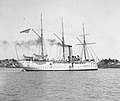Manila incident
The Manila Incident between the United States and the German Empire occurred in 1898 during the Spanish-American War , which also extended to the Philippines .
background
The final phase of the 19th century marked the beginning of both German and US imperialism . The era of the Spanish overseas colonies , however, came to an end in the Spanish-American War. The German Empire, which was ambitious in terms of colonial policy, and the emerging United States competed to take over Spanish possessions in the Far East , where both powers pursued commercial and expansion interests. In 1885 Germany failed in the so-called Caroline dispute in taking over islands in the western Pacific that had been claimed by Spain. Other Pacific islands had meanwhile become German colonies . Just a few months before the Manila incident, Germany also occupied the Tsingtau Bay on the Yellow Sea in China. According to the ideas of German colonial strategists, a base in the Philippines should be the hub of a German colonial empire in Asia and has been a potential expansion target for some time. The USA, too, sought access to the Asian markets via the Philippines as an essential war target in the war against Spain.
course
After defeating the Spanish fleet in Manila Bay , US naval forces blocked the port of Manila . While other great powers only sent smaller units to the scene, which were used exclusively for observation and could not intervene in the battle, a strong squadron was demonstratively assembled by the German side off the coast of the Philippine capital by June 1898. This German association sent to demonstrate its power was roughly on a par with the US fleet: five German cruisers from the I. Kreuzerdivision under Otto von Diederichs faced an ironclad and four US cruisers. The provocative German presence led to tension with the USA and Great Britain .
At the height of the crisis, Admiral George Dewey , the American squadron commander off Manila, is said to have threatened German flag lieutenant Paul von Hintze with the initiation of acts of war. When the German ships withdrew by August 1898, the situation eased somewhat and the immediate danger of war had been overcome.
Reactions and consequences
Germany's actions were sharply attacked by the press in the USA and brought the German Reich the charge of wanting to take over parts of the Spanish colonial possessions. The United States is known to have the same goal.
In the USA, this incident led to a persistent distrust of German foreign policy in general, and especially of imperial naval policy, and the USA supported the British position in the German-British naval battle .
Participating ships (selection)
![]() German Empire (as of June 1898):
German Empire (as of June 1898):
- SMS Kaiser , flagship , large cruiser
- SMS Cormoran , smaller cruiser of Bussard class
- SMS Irene , small cruiser
- SMS Kaiserin Augusta , protected cruiser
- SMS Princess Wilhelm , small cruiser of the Irene class
![]() United States (as of May 1898):
United States (as of May 1898):
- USS Olympia (C-6) , flagship, protected cruiser
- USS Baltimore (C-3) , protected cruiser
- USRC McCulloch , customs cutter
- USS Raleigh (C-8) , Cincinnati- class protected cruiser
- USS Boston , Atlanta- class protected cruiser
Individual evidence
- ↑ Hans-Ulrich Wehler : Bismarck and Imperialism. 4th edition. Deutscher Taschenbuch-Verlag, Munich 1976, ISBN 3-423-04187-0 .
- ↑ Hans-Ulrich Wehler: The rise of American imperialism. Studies on the development of the Imperium Americanum 1865–1900 (= critical studies on historical science . Vol. 10). Vandenhoeck & Ruprecht, Göttingen 1974, ISBN 3-525-35961-6 .
literature
- Willi A. Boelcke : This is how the sea came to us. The Prussian-German Navy overseas 1822 to 1914. Ullstein u. a. 1981, ISBN 3-550-07951-6 , pp. 253 ff.
- Klaus Hildebrand : The past realm. German foreign policy from Bismarck to Hitler 1871–1945. Study edition. Oldenbourg, Munich 2008, ISBN 978-3-486-58605-3 , here p. 207, (partial digitization) .
- Manfred P. Emmes: Germany and the rise of the United States of America to a world power (= political science. Vol. 154). Lit, Berlin a. a. 2007, ISBN 978-3-8258-0738-2 , here p. 41, (partial digitization) .








